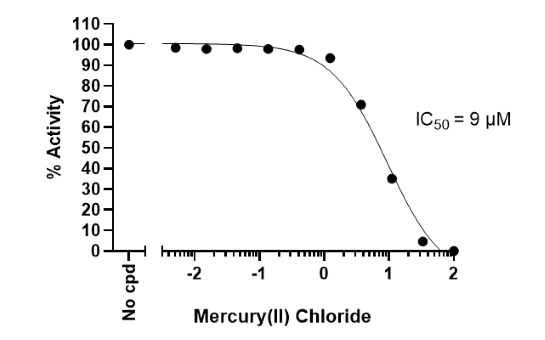GPX4 Fluorogenic Assay Kit
The GPX4 Fluorogenic Assay Kit is a fluorogenic assay designed to measure GPX4 (glutathione peroxidase 4) activity for screening and profiling applications. The assay kit comes in a convenient 96-well format, with enough purified recombinant GPX4, Glutathione, Cumene Hydroperoxide, NADPH, Glutathione Reductase, and GPX4 Assay Buffer for 100 reactions.

Figure 1: Mechanism of detection used in the GXP4 Assay Kit.
GXP4 activity is measured indirectly. GXP4 converts reduced glutathione (GSH) to oxidized glutathione (GSSG) by reducing hydroperoxide (ROOH). GSSG is then converted back to its reduced form by glutathione reductase (GR) in the presence of NAPDH, which is converted into NADP+. NADPH is intrinsically fluorescent, a property lost upon oxidation to NADP+. The decrease in fluorescence (exc λ=340 nm; em λ=450 nm) observed is proportional to the amount of GSSH available for conversion by GR, and to GXP4 activity.
- 50% Ethanol
- Microtiter-plate fluorimeter capable of excitation at λ=340 nm and detection of emitted light at
λ= 450 nm - Adjustable micropipettor and sterile tips
| Catalog # | Name | Amount | Storage |
| GPX4* | 25 µg | -80°C | |
| GPX4 Assay Buffer | 5 ml | -20°C | |
| 10 mM Glutathione | 500 µl | -80°C | |
| 5x Cumene Hydroperoxide (CHP) | 100 µl | -80°C | |
| 2.5 mM NADPH | 400 µl | -80°C | |
| 10x Glutathione Reductase | 50 µl | -80°C | |
| 79685 | Black 96-well plate | 1 | Room Temp |
*The concentration of the protein is lot-specific and will be indicated on the tube.
GPX4 (glutathione peroxidase 4) belongs to the glutathione peroxidase family, which is composed of eight members (GPX1-8). GPX4 is unique in that it is the only monomeric member and can function in cell membranes. It is involved in fighting cellular oxidative stress by preventing membrane lipid peroxidation. Mammalian GPX4 contains a selenocysteine in its catalytic site crucial for reactions to occur and it thus a selenoprotein. GXP4 knock-out in mice results in embryonic lethality, indicating its unique role and limited number of pathways involved in cellular protection from lipid hydroperoxides. Dysfunction of GPX4 results in the accumulation of lipid peroxides and culminates in ferroptotic cell death. GPX4 has been found at high levels in cancer cells and contributes to drug-resistance against lapatinib, palbociclib and other anti-cancer drugs. The inhibition of GPX4 by (1S,3R)-RSL3 decreased the viability of drug-resistant cancer cells and reduced tumor size in mouse models. As the key regulator of ferroptosis and oncogene, GPX4 is thus a promising therapeutical target in cancer therapy.
Zhang X., et al., 2020 J Cell Physiol 235 (4):3425-3437.
Lee J. and Roh J.-L., 2023 Cancer Letters 559: 216119.


